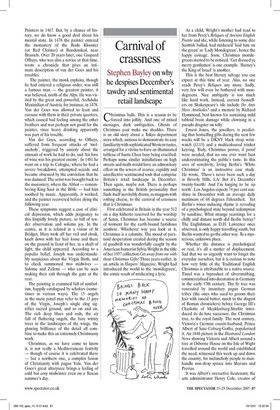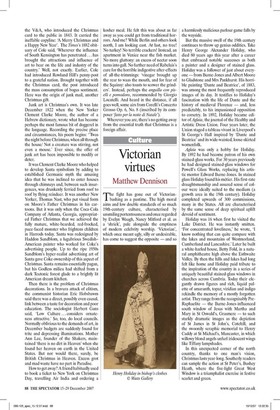Carnival of crassness
Stephen Bayley on why he despises December's tawdry and sentimental retail landscape C4hristmas balls. This is a season to be forced into jollity. And one of mixed messages, dark ambiguities. Ghosts of Christmas past make me shudder. There is an old story about a Tokyo department store which, anxious to demonstrate its easy familiarity with sophisticated Western tastes, arranged for a vitrine to have an illuminated tableau of Santa Claus busy being crucified. Perhaps some similar installations on high streets and malls would have an admonitory effect on the sewers of avarice, cupidity and unreflective sentimental tosh that comprise Britain's retail landscape in December. Then again, maybe not. There is perhaps something in the British personality that finds itself inevitably drawn, as maggots with rotting cheese, to the carnival of crassness that is Christmas.
First celebrated in Britain in the year 512 on a day hitherto reserved for the worship of Satan, Christmas has become a source of torment for the earth-bound fastidious aesthete. Whichever way you look at it, Christmas is a calamity. The mood of paranoid desperation created during the season of goodwill was wonderfully caught by the American humorist Sylvia Wright in the title of her 1957 collection Get away from me with those Christmas Gifts! Three years earlier, in an article in Hatpers' Magazine, Wright had introduced the world to the `mondegreen', the comic result of mishearing a lyric.
As a child, Wright's mother had read to her from Percy's Reliques of Ancient English Poetrie and she, while listening to some dire Scottish ballad, had misheard 'laid him on the green' as 'Lady Mondegreen', hence the happy coinage. Soon, Christmas mondegreens started to be noticed. 'Get dressed ye merry gentlemen' is one example. `Barney's the King of Israel' is another.
This is the best literary salvage you can expect at this time of year. Alas, no one reads Percy's Reliques any more. Sadly, very few will even be bothered with mondegreens. Nice ambiguity is too much like hard work. Instead, current bestsellers on Shakespeare's isle include Do Ants Have Arseholes? and a memoir by Richard Hammond, best known for sustaining mild tabloid brain damage while clowning in a pseudo dragster on telly.
Ernest Jones, the jewellers, is predicting that bestselling gifts during the next few weeks will be a DKNY black strap wristwatch (£115) and a multicoloured trinket keyring. Truly, Christmas proves, if proof were needed, that no one ever went bust underestimating the public's taste. In this area of sensitivity, Irving Berlin's 'White Christmas' is an instructive case study. He wrote, 'There's never been such a day in Beverly Hills, LA/ But it's December twenty-fourth/ And I'm longing to be up north'. Los Angeles expects 74 per cent sunshine in December with an average daily maximum of 68 degrees Fahrenheit. Yet Berlin's wince-inducing rhyme is revealing of a psychological state beyond redemption by sunshine. What strange yearnings for a chilly and distant north did Berlin betray? The Englishman, as D.H. Lawrence once observed, is only happy travelling south, but Berlin wanted to go the other way. To a mysterious, unknown place.
Whether the distance is psychological or real, it's all a matter of displacement. Sad that we so urgently want to forget the everyday ourselves, but it is curious to note how very little of the Traditional English Christmas is attributable to a native source. Tinsel was a byproduct of silversmithing, commercialised into decoration in Germany in the early 17th century. The fir tree was venerated by insanitary pagan German tribes (the ones who used to groom their hair with rancid butter, much to the disgust of Roman chroniclers) before George III's Charlotte of Mecklenburg-Strelitz introduced its de-luxe successor, the Christmas tree, to the royal family. The next century, Victoria's German cousin-husband, Prince Albert of Saxe-Coburg-Gotha, popularised it. An 1848 picture in the Illustrated London News showing Victoria and Albert around a tree at Osborne House on the Isle of Wight travelled around the world and established the need, witnessed this week up and down the country, for melancholy people to manhandle non-drop spruce into Sharans and Previas.
It was Albert's overactive lieutenant, the arts administrator Henry Cole, creator of the V&A, who introduced the Christmas card to the public in 1843. It carried the ineffable copyline: 'A Merry Christmas and a Happy New Year'. The Times's 1882 obituary of Cole said, 'Wherever the influence of South Kensington has penetrated ... has brought the attractions and influence of art to bear on the life and industry of the country.' Well, not exactly. Earlier, Cole had introduced Rowland Hill's penny-post to a grateful nation. Brought together with the Christmas card, the post introduced the mass consumption of bogus sentiment. Here was the origin of junk mail, another Christmas gift.
Junk art is Christmas's own. It was late December 1822 when the New Yorker Clement Clarke Moore, the author of a Hebrew dictionary, wrote what has become perhaps the most famous bit of doggerel in the language. Recording the precise place and circumstances, his poem begins: "Twas the night before Christmas, when all through the house/ Not a creature was stirring, not even a mouse.' Ever since, the offer of junk art has been impossible to modify or deter.
It was Clement Clarke Moore who helped to develop Santa symbolism by adding to established Germanic myth the amusing idea that he was inclined to enter houses through chimneys and, between such insurgences, was drunkenly ferried from roof to roof by flying reindeer. It was another New Yorker, Thomas Nast, who put visual form on Moore's Father Christmas in his cartoons. But it was only when the Coca-Cola Company of Atlanta, Georgia, appropriated Father Christmas that we achieved the fully mature, white-bearded, red-frocked, puce-faced monster who frightens children in Harrods today. Santa was redesigned by Haddon Sundblom, a lugubrious SwedishAmerican painter who worked for Coke's advertising people. Up to the ripe 1950s Sundblom's hyper-realist advertising art of Santa gave Coke ownership of this aspect of Christmas. Santa remains essentially pagan, but his Godless milieu had shifted from a dark Teutonic forest glade to a brightly lit American dream kitchen.
Then there is the problem of Christmas decorations. In a bravura attack of elitism, the communist historian Eric Hobsbawm said there was a direct, possibly even causal, link between a taste for decoration and poor education. The sociologist Herbert Gans said, 'Low Culture ... considers ornateness attractive.' So, too, do local councils. Normally oblivious to the demands of art, in December budgets are suddenly found for trite and depressing illuminations. Mother Ann Lee, founder of the Shakers, maintained 'there is no dirt in Heaven' when she found her heaven on earth in the United States. But nor would there, surely, be British Christmas in Heaven. Excess grot and mad waste have no part in Paradise.
How to get away? A friend habitually used to book a ticket to New York on Christmas Day, travelling Air India and ordering a kosher meal. He felt this was about as far away as you could get from traditional horrors. And me? While Berlin and others look north, I am looking east. At last, no tree! No turkey! No terrible crackers! Instead, an apartment in Venice near the fish market. No more gluttony: an excess of nectar soon turns into gall. No further need of Rabelais's cure for the horrible indigestive after-effects of all-the-trimmings: 'vinegar brought up the rear to waas the mouth, and for fear of the Squinsy: also toasts to scower the grinders'. Instead, perhaps the anguilla con piselli e pomodoro, recommended by Giorgio Locatelli. And heard in the distance, if all goes well, some airs from Corelli's Concerto Grosso Op. 6, No. 8 (inscribed by its composer fatto per la notte di Natale').
Wherever you are, there's no getting away from the essential truth that Christmas is a foreign affair.


































































































 Previous page
Previous page